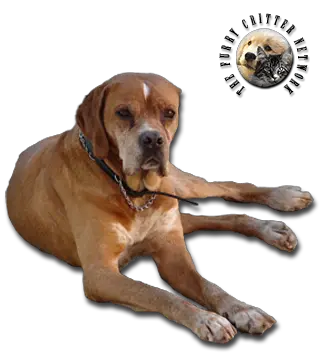Breed Standard
Head: Somewhat heavy, covered with flaccid, thin skin. Square from the front, straight in profile. Slightly domed skull. Pronounced brow bones. Pronounced stop. Straight nosebridge. Pendulous upper lip.
Ears: Medium in length, thin, supple, wide at the base, rounded at the tip. Hanging flat.
Eyes: Large, oval, in different shades of brown, preferably dark.
Body: Can be inscribed inside a square. Straight, long neck with short dewlap. High, broad chest. Short, broad, well-muscled loin. Short, full flanks.
Tail: Thick at the base, tapering toward the tip. Hanging naturally against the thighs. In action, raised level to the ground. Usually docked by one-third.
Hair: Short, thick, lying very flat against the body, not very soft. Fine and close-lying on the head and ears. No undercoat.
Coat: Yellow or chestnut, whole-colored or with white spots.
Size: Dog: 52 to 60 cm; bitch: 48 to 56 cm (19-22 in).
Weight: Dog: 20 to 27 kg (44-59.5 lb) ; bitch 16 to 22 kg (35-48.5 lb).
History
The Portuguese Pointer arose from the ancient Iberian hunting dogs with his presence in Portugal traceable to the early Twelfth Century. Initially the dog was bred in the royal kennels and later became a very popular hunting dog for the lower classes of society. In the Eighteenth Century, many English families established a presence in the region of Oporto in the business of wine production and came to know the Portuguese hunting breed which was taken to England where they played a part in the origin of the English pointer. However, during the Nineteenth Century when Portugal was experiencing considerable social hardships, the breed began a progressive decline. It was not until the 1920s when some breeders made an effort to salvage the breed by locating some of the ancient Portuguese dogs in the inaccessible north of Portugal. The Portuguese pedigree book was then established in 1932 and breed standard in 1938. For at least a thousand years, this dog has always had the same square head, a marked stop, triangular ears and compact look.
Behavior
Tenacious, active, strong-willed, lively, and fast, this dog has a very good sense of smell. These dogs are most valued for their loyalty to the human family. Initially used in hunting feathered quarry (perdigueiro = "partridge"), he has become a multi-purpose hunting dog able to work on any terrain. He tracks with enthusiasm and retrieves very well. He is calm and very affectionate and friendly, making him a good companion. He needs firm training.
He needs space and exercise, as well as regular brushing and checking of the ears.
Function
Hunting Dog, Companion Dog.
Health
Albinism has been known to be a problem in this breed.






